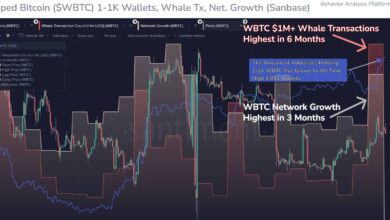
Bitcoin Dips Below $103K ETF Outflows & Fear Grip Market
Bitcoin price falls under $103K as ETF outflows surge and fear sentiment rises. Latest BTC news, market analysis, and what investors need to know today.
The cryptocurrency market is experiencing another turbulent session as Bitcoin witnesses a notable price correction, dropping below the critical $103,000 threshold. This decline comes at a time when institutional investors appear to be pulling back, evidenced by significant outflows from Bitcoin exchange-traded funds. Simultaneously, market sentiment has shifted dramatically toward fear, creating a challenging environment for both retail and institutional participants in the digital asset space.
The recent downturn in Bitcoin price marks a significant moment for the world’s leading cryptocurrency, which had been trading near all-time highs just weeks ago. Investors and analysts are closely monitoring multiple factors contributing to this pullback, including macroeconomic pressures, regulatory concerns, and shifting institutional appetite for digital assets. Understanding these dynamics is crucial for anyone involved in the cryptocurrency ecosystem, whether as a trader, long-term holder, or casual observer of this revolutionary financial technology.
Bitcoin’s Recent Price Decline
The BTC price movement below $103,000 represents more than just a numerical threshold. This psychological barrier had served as strong support over recent trading sessions, and its breach signals a potential shift in market dynamics. The cryptocurrency, which reached unprecedented heights earlier this year, is now facing headwinds that are testing investor resolve and market structure.
Market participants have observed increased volatility across cryptocurrency exchanges, with trading volumes spiking during the downward move. This suggests that the decline isn’t merely a lack of buying pressure but rather active selling from holders who may be taking profits or reducing risk exposure. The digital currency has experienced several sharp intraday swings, characteristic of periods when market sentiment is uncertain and participants are reassessing their positions.
Technical analysts point to several key levels that traders are watching closely. The $103,000 mark wasn’t just a round number but represented a confluence of technical indicators, including moving averages and Fibonacci retracement levels. Breaking below this support could open the door to further downside, with some chartists identifying the next significant support zone around the $98,000 to $100,000 range.
The Impact of ETF Outflows on Bitcoin Markets

One of the most significant developments contributing to Bitcoin’s price weakness is the substantial outflow from Bitcoin ETF products. These investment vehicles, which allow traditional investors to gain exposure to cryptocurrency without directly holding the asset, have been experiencing net redemptions that signal a cooling of institutional enthusiasm.
Exchange-traded funds tracking Bitcoin have seen hundreds of millions of dollars exit in recent trading sessions. This trend represents a stark reversal from earlier periods when these products were attracting massive inflows, helping drive the cryptocurrency to new price discoveries. The shift suggests that institutional investors, who often have longer investment horizons and more sophisticated risk management frameworks, are becoming more cautious about their cryptocurrency allocations.
The ETF outflows carry particular significance because institutional money has been a major driver of Bitcoin’s legitimization and price appreciation over the past several years. When pension funds, hedge funds, and family offices reduce their exposure through these regulated investment products, it removes substantial buying pressure from the market. Furthermore, these outflows can create a feedback loop where declining prices lead to more redemptions, which in turn put additional downward pressure on prices.
Financial advisors and wealth managers have noted increased client concerns about cryptocurrency volatility and regulatory uncertainty. Some institutions are reportedly rebalancing portfolios to reduce overweight positions in digital assets, particularly after the strong gains experienced earlier in the market cycle. This systematic selling differs from panic-driven retail liquidations and can create sustained pressure on prices over extended periods.
Fear and Greed Market Sentiment Analysis
The Crypto Fear and Greed Index, a widely followed metric that aggregates various factors including volatility, market momentum, and social media sentiment, has shifted decisively into fear territory. This market sentiment indicator suggests that investors are becoming increasingly anxious about near-term price prospects, leading to more defensive positioning across portfolios.
High fear sentiment manifests in several observable ways within cryptocurrency markets. Trading volumes often increase as nervous holders liquidate positions, while bid-ask spreads widen as market makers demand greater compensation for providing liquidity during uncertain times. Social media discussions shift from euphoric predictions to concerned analysis, and search interest in terms like “Bitcoin crash” or “cryptocurrency bear market” tends to spike.
Interestingly, contrarian investors often view extreme fear readings as potential buying opportunities. The logic suggests that when sentiment reaches pessimistic extremes, much of the potential selling has already occurred, and prices may be poised for recovery. However, timing such entries remains challenging, as fear-driven markets can remain oversold for extended periods, especially if fundamental concerns persist.
The current fear reading comes amid a confluence of worries extending beyond cryptocurrency-specific factors. Global economic uncertainty, geopolitical tensions, and concerns about monetary policy all contribute to a risk-off environment where investors retreat from speculative assets like Bitcoin in favor of perceived safe havens.
Macroeconomic Factors Influencing Cryptocurrency Markets
The broader economic landscape plays an increasingly important role in Bitcoin price movements as the asset class matures and becomes more integrated with traditional financial markets. Recent macroeconomic data releases have created headwinds for risk assets generally, with cryptocurrencies experiencing amplified reactions due to their higher volatility profiles.
Interest rate expectations remain a crucial variable for cryptocurrency valuations. When central banks maintain higher rates for longer periods, the opportunity cost of holding non-yielding assets like Bitcoin increases. Investors can earn attractive returns from government bonds and money market instruments with minimal risk, making speculative bets on volatile digital assets less appealing from a risk-adjusted return perspective.
Inflation data and employment figures have been closely scrutinized for signals about the economic trajectory and central bank policy intentions. Stronger-than-expected economic indicators can paradoxically hurt cryptocurrency prices by suggesting that interest rates will remain elevated, while weaker data might support digital asset prices by raising hopes for monetary easing. This complex relationship means that BTC investors must maintain awareness of traditional economic metrics that previously seemed irrelevant to the cryptocurrency narrative.
The U.S. dollar’s strength also influences Bitcoin pricing dynamics. Since the cryptocurrency is primarily priced in dollars on major exchanges, a strengthening greenback makes Bitcoin more expensive for international buyers and can dampen demand. Currency fluctuations create an additional layer of complexity for global investors evaluating cryptocurrency allocations.
Regulatory Developments and Market Uncertainty
Regulatory clarity, or the lack thereof, continues to significantly impact cryptocurrency market behavior. Recent statements from financial regulators across various jurisdictions have created an environment of uncertainty that contributes to cautious investor positioning and the current fear sentiment pervading the market.
Government agencies worldwide are grappling with how to appropriately oversee digital assets while balancing innovation concerns with consumer protection mandates. Each regulatory announcement, whether perceived as favorable or restrictive, can trigger substantial price movements as market participants reassess the long-term viability and adoption prospects for Bitcoin and other cryptocurrencies.
Tax treatment of cryptocurrency transactions remains an evolving area that affects investor behavior. As tax authorities develop more sophisticated tracking mechanisms and reporting requirements, some holders face unexpected liabilities that may force sales. The compliance burden associated with cryptocurrency investing has increased substantially, potentially deterring some participants who previously viewed the space as offering greater privacy and flexibility.
Despite these challenges, many industry participants argue that clear regulatory frameworks, even if somewhat restrictive, would ultimately benefit the market by providing certainty and enabling broader institutional participation. The current ambiguity creates hesitation among conservative investors and institutions that might otherwise allocate capital to digital currencies if the regulatory landscape were more defined.
Also Read: Bitcoin Dips Below $109K as CAKE Soars on DeFi and BSC
Technical Analysis and Key Support Levels

From a technical perspective, Bitcoin’s decline below $103,000 has triggered attention to several important chart patterns and support zones. Traders using technical analysis methodologies are closely monitoring price action for signals about whether this represents a temporary correction within an ongoing bull market or the beginning of a more substantial retracement.
The 50-day and 200-day moving averages serve as critical reference points for many market participants. When Bitcoin price trades below these technical indicators, it often signals a shift in intermediate to long-term momentum. The relationship between these moving averages, including whether they maintain a bullish configuration or cross into bearish alignment, provides important context for understanding market structure.
Volume analysis adds another dimension to interpreting price movements. The recent decline has occurred on elevated volume, suggesting conviction behind the selling pressure rather than a simple lack of buyers. High-volume breakdowns of support levels typically carry more significance than low-volume drifts, as they indicate active decisions by market participants to reduce exposure rather than passive drifting.
Fibonacci retracement levels derived from recent swing highs and lows provide potential targets for where the correction might find support. Many technical traders watch these mathematically derived levels for bounce opportunities, creating self-fulfilling prophecies as buying interest clusters around these prices. The psychological impact of round numbers like $100,000 also cannot be understated in cryptocurrency trading.
What This Means for Crypto Investors
The current market environment presents both challenges and opportunities depending on investor time horizons, risk tolerance, and conviction in Bitcoin’s long-term value proposition. For those with shorter trading timeframes, the elevated volatility and uncertain direction create a treacherous environment where quick reversals can produce losses for both bulls and bears.
Long-term holders, often referred to as “HODLers” in cryptocurrency culture, may view the current weakness as a buying opportunity, particularly if they maintain conviction in Bitcoin’s role as digital gold or as a hedge against monetary debasement. These investors typically focus less on short-term price fluctuations and more on fundamental adoption metrics, network security, and the broader narrative around decentralized finance.
Portfolio diversification becomes especially important during periods of heightened volatility. While Bitcoin remains the dominant cryptocurrency by market capitalization and mindshare, the asset class extends far beyond a single token. Investors might consider allocation strategies that balance various digital assets, traditional securities, and other asset classes to manage overall portfolio risk.
Risk management practices like position sizing, stop-loss orders, and regular portfolio rebalancing help investors navigate volatile markets without succumbing to emotional decision-making. The psychological aspects of cryptocurrency investing often prove more challenging than the technical or analytical components, as the dramatic price swings can trigger fear-based selling or greed-driven buying at inopportune moments.
Conclusion
Bitcoin’s decline below $103,000 amid significant ETF outflows and heightened fear sentiment represents a critical juncture for the cryptocurrency market. The convergence of institutional selling pressure, macroeconomic uncertainty, and shifting investor psychology has created headwinds that are testing the resilience of digital asset prices. While short-term volatility seems likely to persist, the long-term trajectory of Bitcoin and the broader cryptocurrency ecosystem remains a subject of intense debate among investors, analysts, and industry participants.
The current market environment underscores the importance of informed decision-making, disciplined risk management, and maintaining perspective during periods of turbulence. Whether this proves to be a temporary correction within an ongoing bull market or the beginning of a more sustained downturn will depend on numerous factors including regulatory developments, macroeconomic conditions, and the evolution of institutional adoption. Investors should remain vigilant, informed, and aligned with their individual financial goals and risk tolerance as they navigate this dynamic and rapidly evolving asset class.
FAQs
Q: Why are Bitcoin ETFs experiencing outflows right now?
Bitcoin ETF outflows reflect several converging factors including profit-taking after substantial gains, institutional portfolio rebalancing, concerns about regulatory uncertainty, and a broader risk-off sentiment affecting all speculative assets. Institutional investors who entered positions earlier may be systematically reducing exposure as part of disciplined investment strategies.
Q: What does the Fear and Greed Index indicate for Bitcoin’s future price?
The Fear and Greed Index measures current market sentiment but doesn’t predict future prices with certainty. Historically, extreme fear readings have sometimes preceded price recoveries as contrarian buying emerges when pessimism reaches peak levels. However, markets can remain in fear territory for extended periods, especially when fundamental concerns persist.
Q: Is now a good time to buy Bitcoin during this price dip?
Whether to buy Bitcoin during a price decline depends entirely on individual circumstances including investment goals, time horizon, risk tolerance, and conviction in the asset’s long-term prospects. Dollar-cost averaging, where investors make regular purchases regardless of price, can reduce the impact of timing decisions and emotional reactions to volatility.
Q: How low could Bitcoin price potentially fall from current levels?
Predicting exact price targets remains speculative, but technical analysts identify several potential support zones based on historical price action and technical indicators. The $98,000 to $100,000 range represents a psychologically significant level with previous support and resistance interactions. Below that, some analysts point to levels around $95,000 or even $90,000 if selling pressure intensifies.
Q: What factors could reverse the current bearish sentiment in Bitcoin?
Several catalysts could potentially shift sentiment from fear back toward optimism. Positive regulatory developments providing clarity on cryptocurrency oversight could remove a major source of uncertainty. Macroeconomic changes such as central bank policy pivots or dollar weakness might rekindle interest in Bitcoin as an alternative asset.







